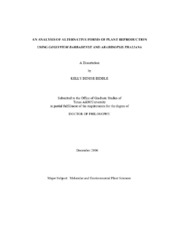| dc.description.abstract | Apomixis holds vast potential for improving agriculture worldwide. It would make plant breeding faster, allow for fixation of hybrid genotypes, and help genetically isolate transgenic crops. However, efforts to introduce apomixis into agriculturally important crops, through either plant breeding or molecular genetics, have failed to produce any new apomictic varieties. This could possibly be remedied if researchers better understood the genetics of apomixis, including the underlying genes, their regulation, and the cellular pathways they control. My work increased our knowledge of these processes by using a mixture of novel methods and underutilized resources. In this study I pursued a two-pronged approach that involved both traditional and reverse molecular genetic techniques. I analyzed the Semigamy mutation from Pima Cotton (Gossypium barbadense), which produces large numbers of haploid and chimeric offspring. Although interesting and potentially useful, little is known about this gene, its expression, regulation, and localization, or the cellular processes in which it is involved. This knowledge advanced our understanding of both this part of apomixis and plant reproduction in general. I was able to determine that the Semigamy mutation is recessive to the wild-type and is incompletely expressed even in the homozygous state. Second, I attempted to recreate the various steps of apomixis in the model species Arabidopsis thaliana using the host of tools made available by its fully sequenced genome. Mutants in various organisms, including microbes, plants, and animals, have phenotypes resembling various components of apomixis, and the sequences of most of the genes involved are available in public databases. I identified homologous Arabidopsis genes by comparing these sequences against the entire Arabidopsis genome. Mutants carrying altered versions of these genes were then studied and characterized using various techniques to see if they had any effect on plant reproduction. This method had not been used to study apomixis before this study and revealed several new reproductive Arabidopsis mutations, specifically those in genes homologous to the S. cerevisiae ste12 and rec8 genes. These results will advance the study of apomixis and potentially enable researchers to one day apply it to agriculturally important crop species. | en |


